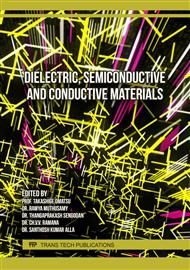[1]
S. Kaur, S. Sharma, A. Umar, S. Singh, S. K. Mehta, and S. K. Kansal, "Solar light driven enhanced photocatalytic degradation of brilliant green dye based on ZnS quantum dots," Superlattices Microstruct., vol. 103, p.365–375, 2017.
DOI: 10.1016/j.spmi.2016.10.046
Google Scholar
[2]
R. Jha, M. Bhushan, and R. Bhardwaj, Studies on Synthesis and Various Characteristics of Green Materials for Energy Conversion Applications. Springer International Publishing, 2020.
Google Scholar
[3]
K. F. Lin, H. M. Cheng, H. C. Hsu, L. J. Lin, and W. F. Hsieh, "Band gap variation of size-controlled ZnO quantum dots synthesized by sol-gel method," Chem. Phys. Lett., vol. 409, no. 4–6, p.208–211, 2005.
DOI: 10.1016/j.cplett.2005.05.027
Google Scholar
[4]
A. Zazueta-Raynaud, R. Lopez-Delgado, J. E. Pelayo-Ceja, M. E. Alvarez-Ramos, and A. Ayon, "Utilization of down-shifting photoluminescent ZnO quantum dots on solar cells," Mater. Res. Express, vol. 4, no. 7, 2017.
DOI: 10.1088/2053-1591/aa7824
Google Scholar
[5]
D. Sharma, R. Jha, and S. Kumar, "Quantum dot sensitized solar cell: Recent advances and future perspectives in photoanode," Sol. Energy Mater. Sol. Cells, vol. 155, p.294–322, 2016.
DOI: 10.1016/j.solmat.2016.05.062
Google Scholar
[6]
J. C. Melendres-Sánchez et al., "Zinc sulfide quantum dots coated with PVP: applications on commercial solar cells," J. Mater. Sci. Mater. Electron., vol. 32, no. 2, p.1457–1465, 2021.
DOI: 10.1007/s10854-020-04916-0
Google Scholar
[7]
M. Shi et al., "'Bottom-up' preparation of MoS2 quantum dots for tumor imaging and their in vivo behavior study," Biochem. Biophys. Res. Commun., vol. 516, no. 4, p.1090–1096, 2019.
DOI: 10.1016/j.bbrc.2019.06.162
Google Scholar
[8]
M. Bhushan, R. Jha, R. Bhardwaj, and R. Sharma, "Visible light emission and enhanced electrocatalytic activity of pure ZnS nanoparticles synthesized via thermal decomposition route," Bull. Mater. Sci., vol. 44, no. 4, 2021.
DOI: 10.1007/s12034-021-02546-8
Google Scholar
[9]
F. Amirian, M. Molaei, M. Karimipour, and A. R. Bahador, "A new and simple UV-assisted approach for synthesis of water soluble ZnS and transition metals doped ZnS nanoparticles (NPs) and investigating optical and photocatalyst properties," J. Lumin., vol. 196, p.174–180, 2018.
DOI: 10.1016/j.jlumin.2017.12.005
Google Scholar
[10]
H. Zhao, Y. Dong, P. Jiang, X. Wu, R. Wu, and Y. Chen, "Facile preparation of a ZnS/ZnO nanocomposite for robust sunlight photocatalytic H2 evolution from water," RSC Adv., vol. 5, no. 9, p.6494–6500, 2015.
DOI: 10.1039/c4ra13203c
Google Scholar
[11]
S. Ummartyotin and Y. Infahsaeng, "A comprehensive review on ZnS: From synthesis to an approach on solar cell," Renew. Sustain. Energy Rev., vol. 55, p.17–24, 2016.
DOI: 10.1016/j.rser.2015.10.120
Google Scholar
[12]
Shreya, A. Yadav, R. Khatri, N. Jain, A. Bhandari, and N. K. Puri, "Double Zone Thermal CVD and Plasma Enhanced CVD Systems for Deposition of Films/Coatings with Eminent Conformal Coverage BT - Advances in Manufacturing Technology and Management," 2023, p.273–283.
DOI: 10.1007/978-981-16-9523-0_31
Google Scholar
[13]
R. Sharma et al., "Controlled growth of α-MoO3 nanostructures with enhanced optical and electrochemical properties without capping agents," Ceram. Int., vol. 46, no. 14, p.23084–23097, 2020.
DOI: 10.1016/j.ceramint.2020.06.085
Google Scholar
[14]
M. Bhushan, R. Jha, R. Bhardwaj, and R. Sharma, "Graphene-doped ZnS nanoparticles synthesized via hydrothermal route for enhanced electrocatalytic performance," Int. J. Appl. Ceram. Technol., vol. 18, no. 5, p.1510–1526, 2021.
DOI: 10.1111/ijac.13801
Google Scholar
[15]
R. Bhardwaj, R. Jha, M. Bhushan, and R. Sharma, "Comparative study of the electrochemical properties of mesoporous 1-D and 3-D nano- structured rhombohedral nickel sulfide in alkaline electrolytes," J. Phys. Chem. Solids, vol. 144, no. April, p.109503, 2020.
DOI: 10.1016/j.jpcs.2020.109503
Google Scholar
[16]
P. PHOGAT, S. Shreya, R. JHA, and S. Singh, "Diffusion Controlled Features of Microwave Assisted ZnS/ZnO Nanocomposite with Reduced Band Gap," ECS J. Solid State Sci. Technol., 2023, [Online]. Available: http://iopscience.iop.org/article/.
DOI: 10.1149/2162-8777/acc426
Google Scholar
[17]
V. H. Choudapur, S. B. Kapatkar, and A. B. Raju, "Structural and Optoelectronic Properties of Zinc Sulfide Thin Films Synthesized by Co-Precipitation Method," Acta Chem. Iasi, vol. 27, no. 2, p.287–302, 2019.
DOI: 10.2478/achi-2019-0018
Google Scholar



